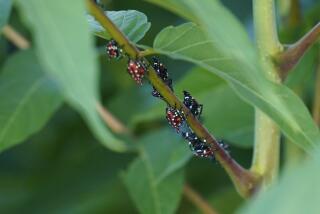Do We Really Need This New Bug With a ‘Humanoid’ Head?
- Share via
Lots of scary news out there, but none worse than this: a new type of Jerusalem cricket has hit town.
It doesn’t have a formal name yet, and scientists are whooping it up because they’ve found the first one in the Santa Ana Mountains along the eastern edge of Orange County. What scientists were doing up there looking for crickets is beyond me.
I go way back with crickets, having been frightened of them as a boy of the plains, where they serenade people on hot summer nights. Problem was, same song every single night and, after a while, it just gave you the creeps. They have a sick habit of making noise until you get close to them, then they clam up, then you walk away and they start up again.
A few years ago, I was surprised to hear crickets in our office here in Costa Mesa. In all honesty, I thought we were a classier operation than that. Somebody must have sent a memo to management, because the crickets seem to have fled the scene.
Now, the news arrives that this new Jerusalem cricket is in the vicinity.
Here’s what the happy scientist who discovered the cricket said: “It makes you wonder how many species there are in California that have gone undiscovered.”
Always eager to get to know new neighbors, I sped to the Internet to learn about the Jerusalem cricket. Here’s what the University of Nevada Cooperative Extension and the state Division of Agriculture had to say about it:
“People are frightened at first when they run across this bizarre-looking creature. They wonder if it is real, and then if it is a quirk of nature.” With all due respect, is this really the kind of new resident we need?
The scientists say the bug can reach 2 inches in length (some reports have it as big as 3 inches!) and describe it as having “unusual features, especially the disproportionally large, bald, shiny, ‘humanoid’ head....Two large, beady eyes are widely set just below long, slender antennae.”
When we see things like that in my neighborhood, we run them out of town.
Needless to say, that isn’t advised here. We’re supposed to welcome it as a vital cog in the ecosystem, even though the bug shows such little respect for its species that the female may eat the male after mating.
The cricket serves as food for our old friends the owl, coyote and fox. And as another Web site points out, “the horsehair worm can inhabit the Jerusalem cricket’s gut and feed.”
If that doesn’t make you want to run out and save a few Jerusalem crickets, nothing will.
It’s not fashionable to speak ill of our fellow eco-travelers, because we’re all God’s creatures and inhabit this planet and must get along with each other. Or something like that. Nor is it my intention to offend any Jerusalem crickets or their advocates, nor to reduce the number of cricket abdomens that horsehair worms can inhabit. Everybody needs a place to go.
It’s just that, alas, I don’t share the excitement of this discovery. And when a scientist says that finding a Jerusalem cricket only makes him wonder how many other species there are out there, I’m forced to respond, “I hope not many.”
If that makes me a bit of an old poop, so be it.
I admit that it’s a poopiness born of fear and ignorance. I don’t like crawling things with regular heads, much less outsized ones that can bite.
Scientists say the cricket lives mostly in the soil and rarely comes out in daylight.
From what I’ve read, then, the chances of me and a Jerusalem cricket ever meeting are slim. “People, often in fear, want to kill them immediately,” say the Nevada bug people. “Resist the temptation in this case. They are not harmful to humans.”
Sorry, I’ve given bugs too many chances in my lifetime, only to be terrorized by them later.
And when it comes to large, shiny, humanoid-headed, beady-eyed crickets with a belly full of horsehair worms, I’m not making any promises.
*
Dana Parsons’ column appears Wednesdays, Fridays and Sundays. Readers may reach Parsons by calling (714) 966-7821 or by writing The Times’ Orange County edition, 1375 Sunflower Ave., Costa Mesa, CA 92626, or by e-mail to dana.parsons@latimes.com.






